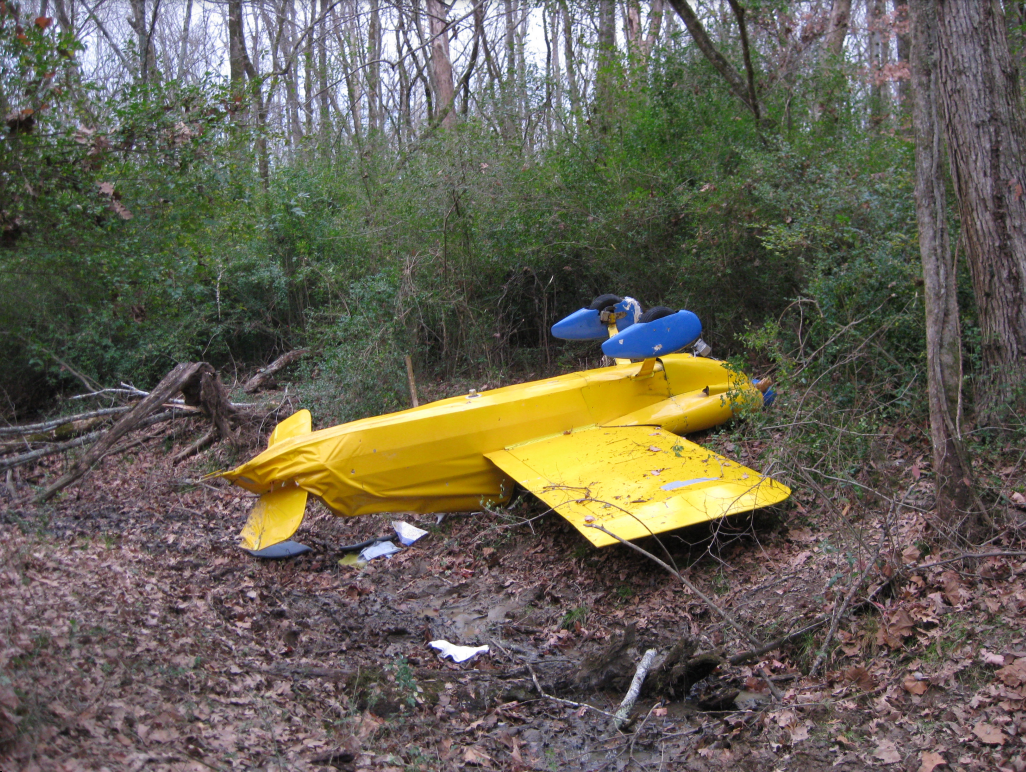
ASN Wikibase Occurrence # 150996
This information is added by users of ASN. Neither ASN nor the Flight Safety Foundation are responsible for the completeness or correctness of this information.
If you feel this information is incomplete or incorrect, you can submit corrected information.
| Date: | Sunday 2 December 2012 |
| Time: | |
| Type: |  Cassutt Sport Racer |
| Owner/operator: | Private |
| Registration: | N9CA |
| MSN: | CKA1 |
| Year of manufacture: | 1991 |
| Engine model: | Continental C85 SERIES |
| Fatalities: | Fatalities: 1 / Occupants: 1 |
| Aircraft damage: | Substantial |
| Category: | Accident |
| Location: | near Collegedale Municipal Airport (FGU/KFGU), TN -
 United States of America United States of America
|
| Phase: | Approach |
| Nature: | Private |
| Departure airport: | Collegedale Municipal Airport, TN (KFGU) |
| Collegedale Municipal Airport, TN (KFGU) | |
| Investigating agency: | NTSB |
| Confidence Rating: |
On December 2, 2012, at an unknown time, an experimental amateur-built Cassutt Sport Racer, N9CA, was substantially damaged when it impacted trees and terrain while on approach to Collegedale Municipal Airport (FGU), Collegedale, Tennessee. The private pilot was fatally injured. Visual meteorological conditions prevailed, and no flight plan was filed for the flight, which departed FGU around 1600. The personal flight was operated under the provisions of Title 14 Code of Federal Regulations Part 91.
The pilot indicated to a friend that the purpose of the flight was to practice takeoffs and landings in the airport traffic pattern. An airport employee reported that he observed the airplane depart normally from runway 21 but that he did not see the airplane return to the airport before he left for the night about 1.5 hours later. An alert notice was issued the following day when the airport manager observed the pilot's car still parked at the airport. Local authorities found the wreckage the day after that. The airplane was found inverted among trees on an approximate northeast heading about 1/4 mile north of the runway 21 threshold, consistent with an approach for landing on the runway. Broken tree branches were located near the wreckage and continued in a northwesterly direction from the wreckage. Postaccident examination of the airframe and engine revealed no evidence of any preimpact mechanical malfunctions or failures that would have precluded normal operation.
The pilot did not hold a valid Federal Aviation Administration medical certificate. He applied for a third-class medical certificate 8 years before the accident, but it was deferred due to a history of severe heart disease. The pilot's autopsy results revealed a significantly enlarged heart with a mechanical mitral valve in place and severe coronary artery disease that included 90-percent occlusion of the left anterior descending, circumflex, and right main arteries and complete occlusion of the three bypass vessels. These conditions put the pilot at high risk for a sudden cardiac arrhythmia, which could result in sudden incapacitation and would not be evident during an autopsy.
Toxicological testing detected the presence of two blood pressure/cardiovascular medications, an antidepressant and its metabolite, a cough medication, an anticoagulant, a sedating antihistamine (diphenhydramine), and a sedating antinausea medication (promethazine). The diphenhydramine detected in the blood was within the normal therapeutic range; however, the promethazine detected in the blood exceeded the normal therapeutic range. Both drugs carried the warning, "may impair mental and/or physical ability required for the performance of potentially hazardous tasks (e.g., driving, operating heavy machinery)." The use of diphenhydramine together with promethazine, particularly in the elderly (the pilot was 82 years old) or those with a debilitating condition, may increase side effects such as drowsiness, rapid heartbeat, confusion, and memory problems.
Probable Cause: Impact with trees and terrain during the landing approach likely due to the physiological incapacitation of the pilot.
Accident investigation:
 |
|
Sources:
NTSB
Location
Images:


Photos: NTSB
Revision history:
| Date/time | Contributor | Updates |
|---|---|---|
| 04-Dec-2012 23:29 | gerard57 | Added |
| 05-Dec-2012 00:14 | Geno | Updated [Aircraft type, Registration, Cn, Location, Phase, Source, Damage, Narrative] |
| 05-Dec-2012 00:21 | Geno | Updated [Departure airport, Destination airport, Source] |
| 21-Dec-2014 17:22 | Flier1 | Updated [Damage] |
| 21-Dec-2016 19:28 | ASN Update Bot | Updated [Time, Damage, Category, Investigating agency] |
| 28-Nov-2017 14:01 | ASN Update Bot | Updated [Time, Operator, Other fatalities, Departure airport, Destination airport, Source, Narrative] |
| 02-Jul-2022 18:36 | rvargast17 | Updated [Damage] |
| 13-Oct-2022 11:01 | Captain Adam | Updated [Other fatalities, Location, Phase, Departure airport, Destination airport, Damage, Narrative, Photo] |
| 13-Oct-2022 11:01 | Captain Adam | Updated [Departure airport, Destination airport, Photo] |
Corrections or additions? ... Edit this accident description
The Aviation Safety Network is an exclusive service provided by:


 ©2024 Flight Safety Foundation
©2024 Flight Safety Foundation